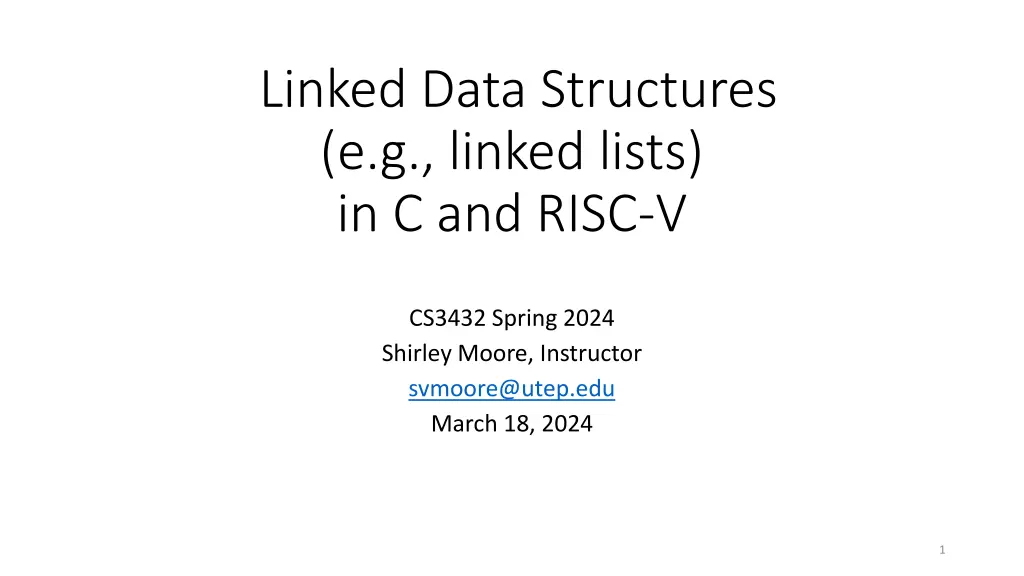
Learn Linked Data Structures in C and RISC-V
"Explore linked lists, arrays, pointers, and structures in C and RISC-V with practical examples and objectives set for the week's learning. Enhance your coding skills in data structures."
Download Presentation

Please find below an Image/Link to download the presentation.
The content on the website is provided AS IS for your information and personal use only. It may not be sold, licensed, or shared on other websites without obtaining consent from the author. If you encounter any issues during the download, it is possible that the publisher has removed the file from their server.
You are allowed to download the files provided on this website for personal or commercial use, subject to the condition that they are used lawfully. All files are the property of their respective owners.
The content on the website is provided AS IS for your information and personal use only. It may not be sold, licensed, or shared on other websites without obtaining consent from the author.
E N D
Presentation Transcript
Linked Data Structures (e.g., linked lists) in C and RISC-V CS3432 Spring 2024 Shirley Moore, Instructor svmoore@utep.edu March 18, 2024 1
Schedule for Todays Class Announcements 6-weeks course survey on QuestionPro Thank you to all who completed it. Can still fill it out if you haven t already (see link on General channel in Teams). We have discussed the results and will address them. Please see Robert for adjustments to lab grades. Lecture Quiz 3 assigned on BlackBoard, due Sunday, March 3, 11:59pm Midterm Exam will be in-class, closed-book, on paper, Wed., March 6. Midterm exam review during March 4 class Procedures in C and RISC-V (cont.) (slides 12-19 from Feb. 21 class) Procedures with array arguments Encoding jal and jalr instructions Practice problems -- P&H 2.29, 2.30, 2.31 Indirect function/procedure calls Arrays and Pointers in C and RISC-V K&R Chapter 5 P&H 2.9, 2.14 2
Learning Objectives for this week After this week s lectures and practice problems, you should be able to do the following: Write C code that uses arrays and translate to to RISC-V Including arrays of pointers. Write C code that use structures and translate to RISC-V Write C code that uses malloc() and free() and translate to RISC-V. Write C code that manipulates linked lists and translate to RISC-V Write C code that uses a combination of arrays and structs Array of structs Struct of arrays (In general, an array can be a member of a struct). Nested structs (A struct can be a member of a struct). Give results produced by any of the above. The above includes functions/procedures with array and pointer arguments, including when the pointer is the address of a struct. 3
Pointers in C A pointer is a variable that can contain the address of a variable. A pointer in C is constrained to point to a specific type (with the exception of pointers of type void * (pointer to void i.e., a generic pointer). Pointers is assembly/machine language are not typed; they are byte addresses. In C, there is a strong relationship between pointers and arrays. Any code written using array subscripting has an equivalent version that uses pointers. Pointer version is usually faster A compiler will often generate assembly/machine code analogous to the C pointer version, even if the C code is written using subscripting. 4
Array Example (K&R p. 98) pa = a; is the same as pa = &a[0]; a[i] is equivalent to *(a+i) &a[i] is equivalent to a+i
Array Arguments in C When an array name is passed to a function, what is passed is the address of the zeroth element. The function can believe it has been passed either an array or a pointer. Can pass part of an array to a function. Example on next slide: Use copy() (from Example 7 from Feb. 21 class) to copy right half of array X to array Y, where X is of size 2*n ints and Y is of size n ints. 6
Array copy function (Example 7 from Feb. 21 slides) void copy (int a[], int b[], int n) { Copy right half of array X to array Y, where for (int i = 0; i < n; i++) X is of size 2*n ints and Y is of size n ints. a[i] = b[i]; } copy(Y, X+n, n); Same as void rhcopy (int *a, int *b, int n) { int *end = a + n; while (a < end) { *a = *b; a++; b++; } } 7
Structs in C K&R Chapter 6 8
Example using struct point The init_point() function below allocates memory for a point struct and initializes the fields to x, y, (*ft)(x,y), and (*fp)(x,y). Translate to RISC-V using Compiler Explorer with O1 and explain the resulting assembly code. struct point *init_point(int x, int y, float (*ft)(int, int), float (*fp)(int, int)) { p = (struct point *) malloc(sizeof (struct point)); p.x = x; p.y = y; p.temp = (*ft)(x,y); p.pressure = (*fp)(x,y); return p; } 9
